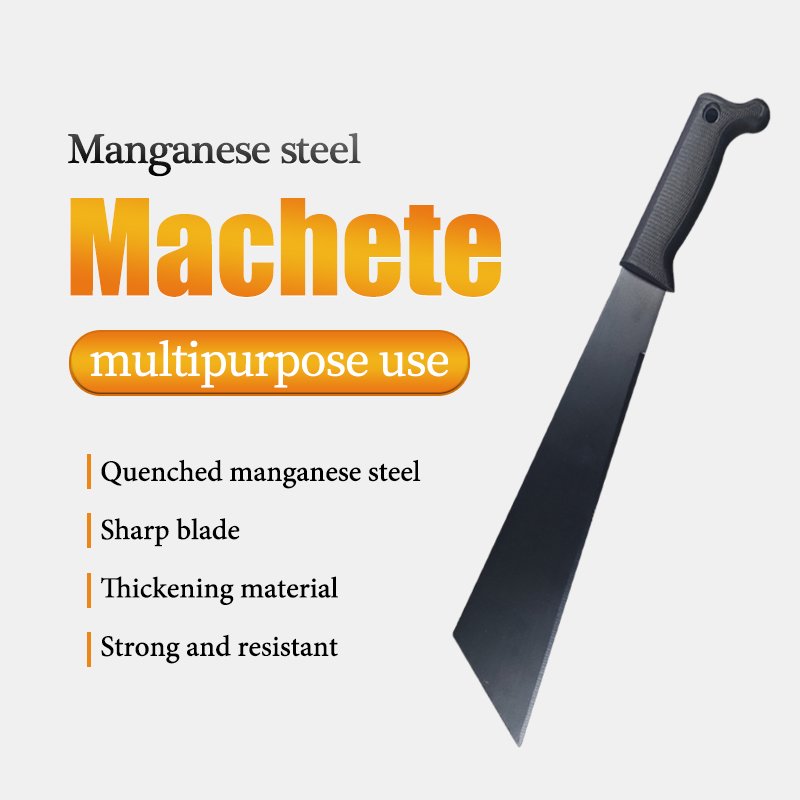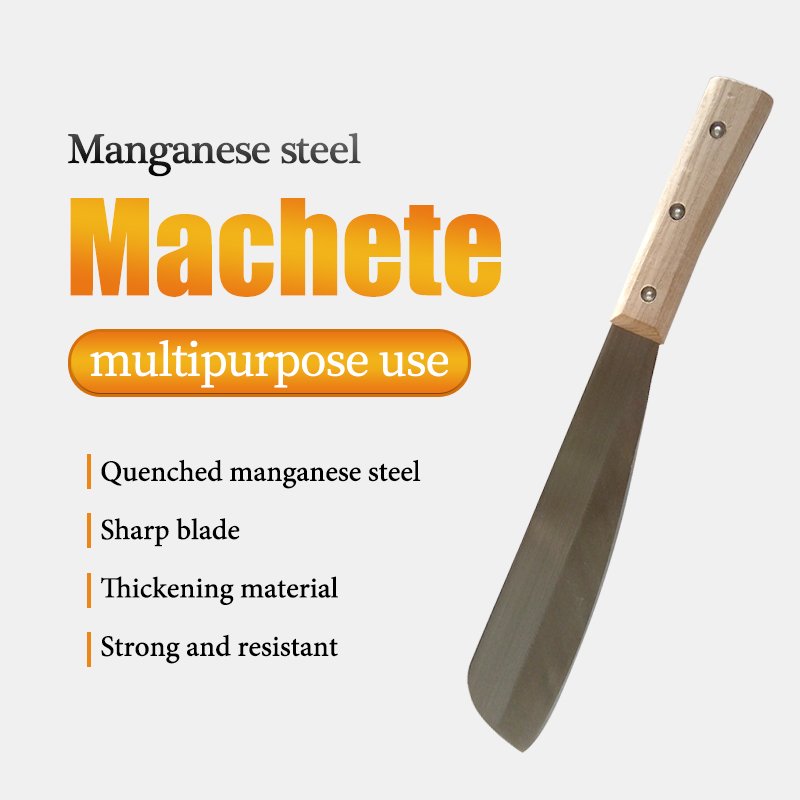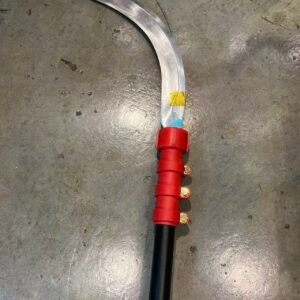1. Understanding the Role of a Short Machete in African Terrain
In many regions across Africa, short machetes have become essential tools for daily labor and survival. Whether clearing brush in Nigeria, harvesting sugarcane in Kenya, or cutting trails through dense foliage in Uganda, the short machete is trusted for its portability, efficiency, and precision. Unlike traditional long machetes, short machetes—typically measuring between 10 to 16 inches—offer greater control in confined or overgrown spaces.
The African landscape is uniquely diverse, ranging from thick savannahs to mountainous farmlands and forested riverbanks. In such environments, users often encounter dense undergrowth or tight working areas where large machetes become unwieldy. A short machete delivers fast, agile strikes with minimal fatigue, allowing users to work longer and with greater accuracy. Its design supports tasks that require maneuverability, such as pruning crops, building shelters, or even skinning game.
Short machetes also cater well to everyday laborers and small-scale farmers who value tools that are easy to carry on foot. Whether strapped to a belt or carried by hand, these compact blades provide utility without bulk, making them ideal for mobile use.
Additionally, the short blade machete aligns well with traditional hand techniques common in African rural communities. From village-level agriculture to artisanal clearing operations, the demand for short machete solutions continues to grow—especially among those who appreciate the balance between compact size and cutting power. As the need for affordable, versatile tools rises across Africa, the machete remains a top pick for those seeking reliable performance under rugged conditions.

2. What Makes the Best Short Machete for Field Efficiency?
Selecting the best short machete requires more than just choosing a smaller blade. It involves balancing multiple performance factors that contribute to both comfort and effectiveness in the field. For professional users across Africa, a high-quality short machete must combine ergonomic design, durable materials, and practical blade shape.
First, blade design plays a central role. Straight-edged short blade machetes provide clean slicing, ideal for agricultural uses such as trimming corn or cassava. Curved blades, on the other hand, deliver powerful chopping force for thick vegetation. Styles like Panga or Bolo are often shortened for precise bush-clearing work. A well-designed machete pick takes blade curvature into account to suit local terrain and vegetation types.
Material selection is equally critical. The best machetes feature high-carbon steel or manganese-enhanced alloys to resist rust and hold a sharp edge over time. In tropical climates, these properties ensure performance even with daily use under wet and muddy conditions.
Another key factor is the handle. Whether made from hardwood, polymer, or rubber-coated metal, the grip must provide stability and comfort. Slippage in sweaty or rainy conditions can reduce efficiency and increase risk, so a textured, well-balanced handle is essential.
For professionals and distributors sourcing tools for African labor markets, blade length matters too. A 10 to 14-inch blade is often optimal for combining reach with maneuverability. This range allows operators to manage detailed work in gardens or farms while still being robust enough to clear brush or small branches.
Ultimately, the best short machete is one that’s forged with the end-user in mind. It should meet the region’s specific demands, adapt to common tasks, and withstand rigorous field conditions—all while being cost-effective and easy to maintain.

3. Factory-Direct Short Blade Machete Picks from Our Company
Our company specializes in producing durable, cost-effective short blade machetes specifically designed for African markets. With over 30 years of manufacturing experience and a deep understanding of local agricultural and forestry needs, we offer factory-direct solutions that combine affordability, quality, and customization.
Our most popular product line includes the Short Panga Machete—a compact version of the traditional Panga blade, ideal for clearing brush and vegetation. With a 12-inch high-carbon steel blade and a contoured wooden handle, it provides excellent balance and cutting power for dense African foliage.
Another customer favorite is the Curved Compact Bush Machete, designed with a reinforced spine for extra durability. This model is commonly used in Uganda and Tanzania for heavy-duty field clearing. Its 14-inch blade and ergonomic grip allow for extended use without discomfort, making it a top pick for field professionals.
For regions with sugarcane or banana farming, our Short Cane Knife Machete delivers precision and fast harvest cutting. It features a straight-edged 10-inch blade with a non-slip polymer grip, available in bulk for cooperative farms or supply chains.
We offer OEM and ODM services to support distributors, wholesalers, and government procurement programs. Clients can customize logos, handle materials, packaging, and blade length to suit regional preferences. All products undergo strict quality control and are shipped in reinforced cartons for safe transit across long-distance routes.
With supply hubs positioned for easy export to East, West, and Central Africa, we ensure fast lead times, competitive pricing, and responsive support. Whether you’re sourcing for rural markets, government tenders, or agricultural NGOs, our short machete catalog is your reliable factory-direct solution.

4. How to Select the Right Machete Pick for Local Tasks
Choosing the right machete pick requires aligning blade features with the specific field tasks and environmental conditions faced by users. For African buyers—whether individual farmers or procurement managers—matching tool to task is essential for productivity and long-term value.
For farming purposes, short machetes are widely used to cut through maize stalks, prune trees, or harvest sugarcane. In this context, a straight-edged short blade machete offers speed and control. For dry zones with tough vegetation, weighted machete picks are preferred for more powerful swings.
In forestry or rural development work, curved blades offer more chopping leverage, particularly for thorny bushes or hardwood saplings. In South Sudan and Ethiopia, for instance, machete picks with slight hook ends improve efficiency in field clearing. In contrast, the Congo Basin’s rainforests favor cutlass machetes with corrosion-resistant coatings due to constant exposure to moisture.
Urban users, such as landscapers or building crews, often prefer compact machetes for trimming hedges or removing debris in narrow areas. Lightweight designs with reinforced blades are ideal in this case.
Buyers should also consider handle design. In humid or rainy regions, non-slip synthetic handles offer better grip and hygiene. For arid areas, treated wood handles provide traditional appeal and sufficient durability.
Procurement managers can benefit from buying machete picks in assorted blade styles and lengths to accommodate regional diversity. Partnering directly with factories—like ours—allows for product customization and consistent quality. Bulk discounts, shipping support, and multilingual after-sales service ensure smooth operations for resellers and importers.
Making the right machete pick is about understanding the user, the terrain, and the work. With careful selection and proper supply chain support, short machetes can drive real productivity improvements across Africa’s fields and forests.

5. How Short Can a Machete Be? Exploring Design Limits
While traditional machetes typically range from 18 to 24 inches, the evolution of machetes has challenged these norms. Today, some highly functional machetes feature blades as short as 8 inches, without compromising on utility—especially when used for compact tasks in agriculture, forestry, and survival situations.
The key to shortening a machete without losing effectiveness lies in engineering. Thicker spines, forward-weighted designs, and premium steel can give a short blade surprising power. These ultra-compact machetes bridge the gap between a knife and a traditional machete, making them excellent for close-quarter use or as secondary tools.
Short machetes are particularly valuable for clearing tight underbrush or processing tasks like peeling bark, harvesting crops, or chopping small logs. In the Congo, for example, bushcrafters and farmers often carry both a long machete and a short blade for different stages of the job. The short model provides agility and reduces hand fatigue over long work sessions.
Additionally, some short machetes are designed as multi-tools, with integrated sawbacks, pry tips, or even sharpened hooks—offering greater versatility in one compact form. This hybrid concept is gaining popularity in outdoor, tactical, and aid-relief contexts.
It’s important to note that the minimum effective length also depends on the user’s experience and intended application. While shorter blades offer more precision, they may require more effort in tasks like thick chopping or batoning. That said, for users who need control, convenience, and portability, the modern short blade machete is a proven solution.
In summary, the design limit of a machete is less about size and more about smart engineering. When crafted well, even the shortest machete can perform reliably in Africa’s most demanding environments.
About us:
Dingzhou Gemlight Cutting Tools Co., Ltd.,With a solid foundation since 1990, Gemlight machete is a trusted name in the field of cane machete manufacturing. We focus on R&D, design and production to produce high quality wholesale china machete and shovel,hoe,pickaxe,sickle,farm tools.
Gemlight Machete factory Based in Baoding, Hebei, China, we benefit from efficient logistics and fast delivery. Our products have been well received in more than 50 countries, thanks to our commitment to customer satisfaction




